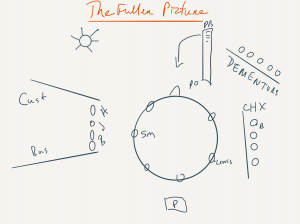The Fuller Picture of the Scrum Team
What does the Scrum Team look like in context?
In ScrumLand there are many many pictures of this. Here is one that is a bit different.
In this case, the context is not the process but other things and other people.
See here:
One could start many places in describing this picture. I’ll start this way.
1. The Vision. The vision is like a North Star to the Team. Keeps them focused and motivated. They want to do the work. I usually think of it as the Vision of the Product, which is a (part of a) solution to a customer problem.
2. Customer. The customer is those people to whom we are deliverin the product. It is more blessed to give than to receive. (Sure, in business, we also get paid.)
3. Business. These people (in this sector) represent the business and its needs. For example, a for-profit firm needs to make a profit usually. But there are many other possible concerns that could be important.
Note: The BSHs (business stakeholders) represent the customer and the business side. The BSHs (as I define them) are part-timers. But good, and important.
4. The Team!! Of course they are important. And for many reasons, one being that they are human beings with god-given rights and a god-given inherent value. But also, practically, they build they product.
5. The Product Backlog (PB). The list of all of the work the Team will do, mainly in the form of User Stories. The User Stories represent (mostly) features to be added to the Product.
6. The Product (P). This is what the Team (mainly) produces.
7. The Chickens (CHX). This …area….is the single most important thing on this picture. Not because the Chickens really are THAT important, but because so many people (in my experience) leave them off. And they are essential.
So, the Team represent the “pigs”, the committed (and I want them 100% committed in a professional team. For example, to only 1 team.
The CHX (the Chickens) are “only involved”. So, they may be vary talented and very helpful, but they are not committed to our work as a Team. As a consequence, they typically are not as reliable (to us, for our product).
So, we have to put them in the picture. Name names. Manage them, and make it work with them in the picture.
Hope this picture helps you.
« « New HBR article… Agile at Scale || What is Agile Transformation? » »

